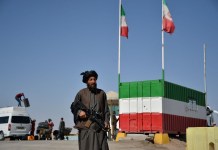The United States under the leadership of President Donald Trump has left no stone unturned in its attempts to cripple Iran, be it the re-imposition of the UN arms embargo which expire this month or the imposition of fresh sanctions on Tehran’s financial sector.
The US has unilaterally imposed sweeping sanctions on Iran’s financial sector in a move that experts believe could have serious outcomes, including a pernicious impact on the ability of the Iranian people to access humanitarian supplies.
However, while Iran battles to let loose from Washington’s firm grip, the scenario might just play out as a smokescreen with President Hassan Rouhani seemingly bolstering his homeland’s defensive capabilities in military radar technology from right under Trump’s nose.
According to multiple Iranian news reports, Tehran is touted to be one of the world leaders in radar technology with the deployment of new defence systems within its boundaries, hinting at the possibility of Iran acquiring or on verge of acquiring the lethal S-400s from Russia.
The Yazd Province lying under the Central part of the country is reported to be deployed with the latest military radar systems, with Islamic Revolution Guards Corps (IRGC) Aerospace Force Brig.-Gen. Amir Ali Hajizadeh commending its capabilities.
“These radars can detect [missiles or drones] within a radius of 350 km and up to an altitude of 1,000 km.” (The Iranian military capabilities) were definitely in the top 10 in the world,” said Hajizadeh.
The specifications regarding the range of the missiles are considered somewhat similar to the deadly stealth-killing S-400s or S-300s, with the modern long and medium-range surface-to-air missile systems (SAM) capable of engaging targets at a range of up to 400 kilometres.
Moreover, what cements the doubts is the fact that just days prior to this, Russia’s Ambassador to Iran, Levan Dzhagaryan, had fuelled the debate of Tehran acquiring the much-coveted defence missiles after stating that Vladimir Putin’s homeland would have no problems selling them the missiles.
“We have said since the very first day that there will be no problem selling weapons to Iran from October 19,” said Dzhagaryan told a news agency.
Last month, the Trump administration had issued a warning to those who violated the “snapback” UN sanctions which it said had been enforced.
However, Dzhagaryan seemed to have brushed off the US threat and highlighted how a deal which saw Russia deliver S-300 defence systems to Iran could be repeated with Moscow supplying Tehran with the S-400s if it is requested after the expiry of the current sanctions on October 18.
“As you know we have provided Iran with S-300. Russia does not have any problem to deliver S-400 to Iran and it did not have any problem before either,” said Dzhagaryan
Considered to be the most advanced of its kind, S-400 surface-to-air-missiles are intricately designed to detect and destroy aircraft and cruise and ballistic missiles, while also possessing the strength to eliminate ground-based installations.
The systems which entered Russian service in 2007 can engage targets up to six times the speed of light and can also launch 40N6 missiles (long-range, hypersonic, Surface-to-Air Missiles) to engage low manoeuvrable aerodynamic targets.
Iran for long has been considered to be one of the countries interested in procuring the missiles which are the only defence systems allegedly capable of tracking and taking down the most sought after US F-35 stealth fighter jets.
On Wednesday (October 07), Putin held a dialogue with President Benjamin Netanyahu over a phone call with Iran being at the centre of it.
However, while there is secrecy on a potential deal for the S-400s to Iran, there is a heightened possibility of the country boasting powerful radar systems which would be aimed at the US, Israel and other nations as Tehran would look to equip its allies Syria, Iraq and others in exporting the modern systems.
Two sets of homegrown Qadir long-range radar systems connected to the countrywide air defence network had reportedly become operational on Tuesday (October 06).
The systems developed by IRGC, who had already deployed eight Qadir radars across Iran, can detect targets with small cross-section areas while also boasting the ability to spot various stealth aircraft.
Regardless of a future deal of an S-400 between Iran and Russia, Tehran might already have a radar system as strong as an S-400 without actually possessing it, an idea which will be unsettling for officials sitting at the Pentagon, who have done everything in their might to isolate Iran militarily.




